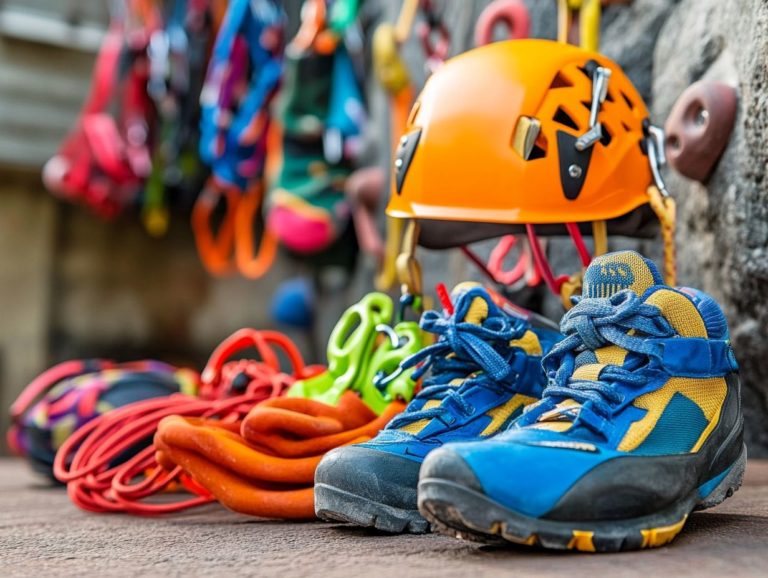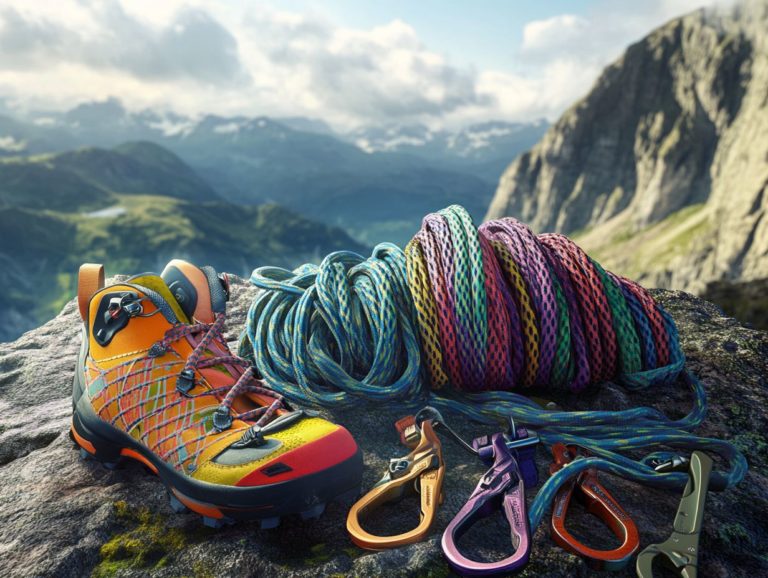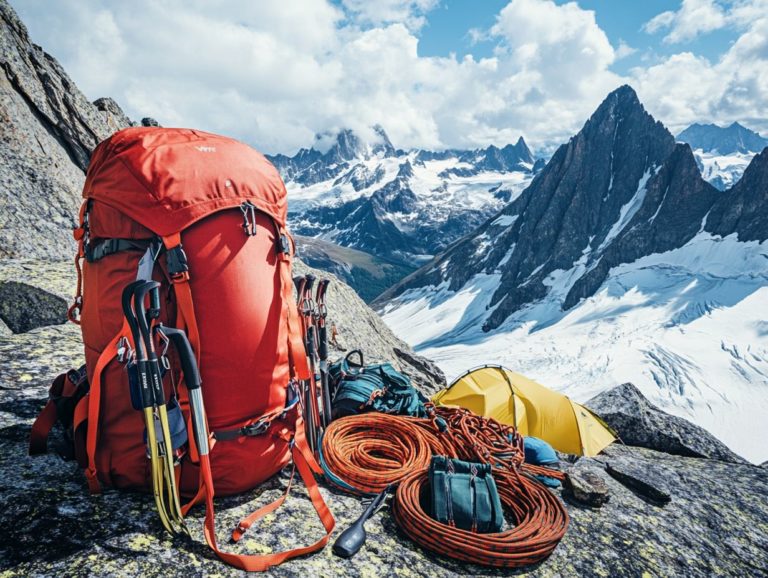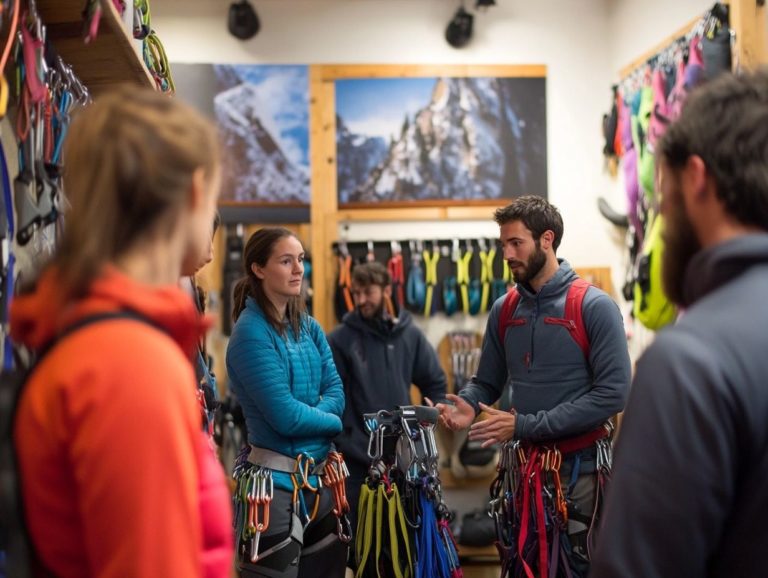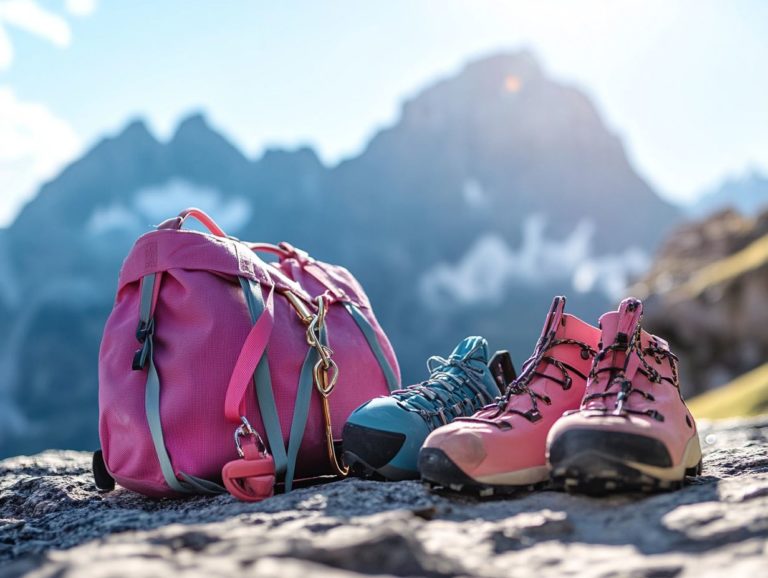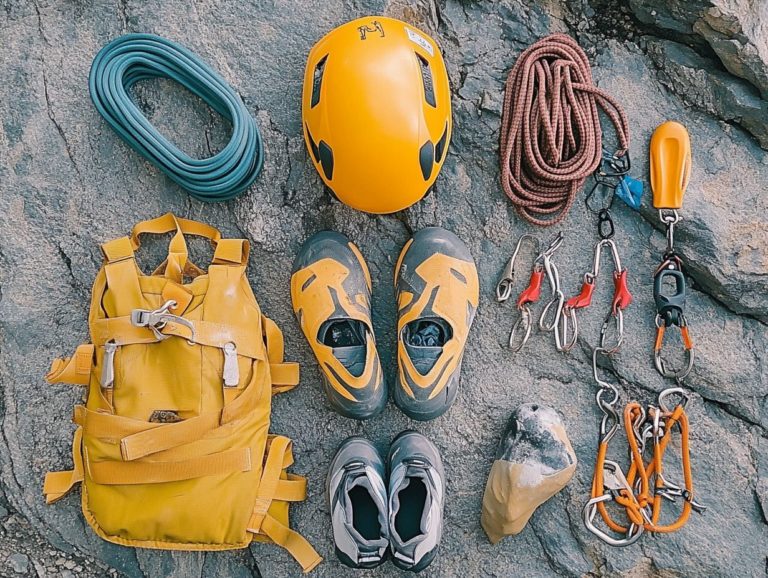What Makes a Good Climbing Crash Pad?
When it comes to bouldering, safety should always be your top priority. A climbing crash pad is an indispensable piece of gear for every climber.
This article delves into what constitutes an excellent climbing crash pad. It highlights essential features such as impact absorption, durability, portability, and comfort.
It also covers the various types of pads available, ranging from foam to air. This will guide you in selecting the right one based on your climbing style and budget.
Whether you re a seasoned pro or just beginning your climbing journey, understanding these elements will enhance your experience and keep you safe on the rock.
Contents
- Key Takeaways:
- Key Features of a Good Climbing Crash Pad
- Types of Climbing Crash Pads
- Choosing the Right Climbing Crash Pad
- Considerations for Different Climbing Types
- Budget and Personal Preferences
- Frequently Asked Questions
- What Makes a Good Climbing Crash Pad?
- What Materials Are Best for a Climbing Crash Pad?
- Are Thicker Crash Pads Always Better?
- What Features Should I Look for in a Climbing Crash Pad?
- How Many Crash Pads Do I Need for Bouldering?
- Can I Use a Climbing Crash Pad for Other Outdoor Activities?
Key Takeaways:
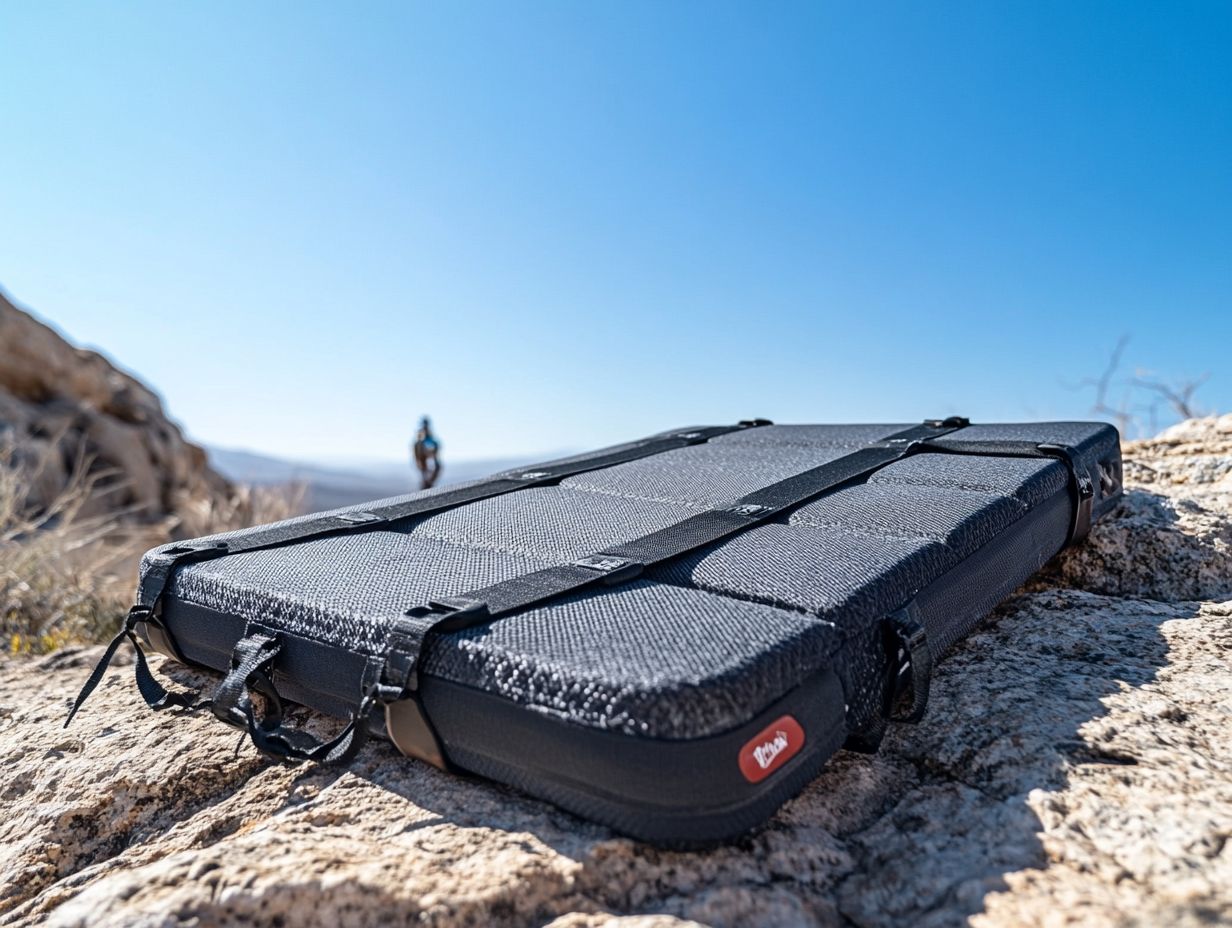
- A good climbing crash pad should offer impact absorption and durability to protect the climber from falls.
- Portability and size are important factors to consider when choosing a climbing crash pad, as it should be easy to transport and fit comfortably in different climbing environments.
- The right climbing crash pad depends on your climbing style, budget, and personal preferences, so consider these factors before making a purchase.
What is a Climbing Crash Pad?
A climbing crash pad is essential safety equipment, especially for bouldering. It provides the cushioning you need during falls.
Typically crafted with a durable nylon shell, these pads are designed to absorb impact using high-quality foam. This helps prevent injuries while you tackle challenging boulder problems outdoors.
As climbing gains popularity, recognizing the purpose and importance of crash pads is vital for both newcomers and seasoned climbers.
These pads enhance your safety, allowing you to push your limits with confidence. The blend of materials boosts durability and ensures effective shock absorption.
This means that even if you miscalculate a landing, your risk of serious injury is significantly minimized. Advanced crash pads often include enhanced safety features such as anti-slip bottoms and foldable designs.
This makes them easier to transport while ensuring they stay securely in place during use. Choosing a quality crash pad is a game changer for your climbing adventures!
Key Features of a Good Climbing Crash Pad
When choosing a climbing crash pad, consider several essential features that dictate its effectiveness and suitability for your climbing style. Key aspects like impact absorption, durability, and foam density play a crucial role in your decision.
A well-designed pad provides reliable impact protection whether you re tackling tall boulders that require careful climbing or navigating challenging problems.
Impact Absorption and Durability
Impact absorption and durability are crucial features of an effective climbing crash pad. These ensure you stay protected during falls while withstanding the inevitable wear and tear of outdoor bouldering.
The foam’s density significantly influences its ability to absorb shock from falls. A durable cover crafted from high-quality materials enhances the pad’s longevity.
When you’re choosing a crash pad, it’s vital to understand the differences between foam types, particularly open cell and closed cell variants. Open cell foam excels in energy absorption, adapting seamlessly to the shape and force of a fall.
This makes it an exceptional choice for cushioning impact. Closed cell foam offers remarkable resilience and can handle repeated impacts. This is particularly beneficial for heavier climbers or those tackling tall falls.
A robust exterior cover does more than just protect the foam from abrasions and moisture. It also contributes to the overall functionality of the crash pad, ensuring it withstands multiple climbs and changing weather conditions.
Portability and Size
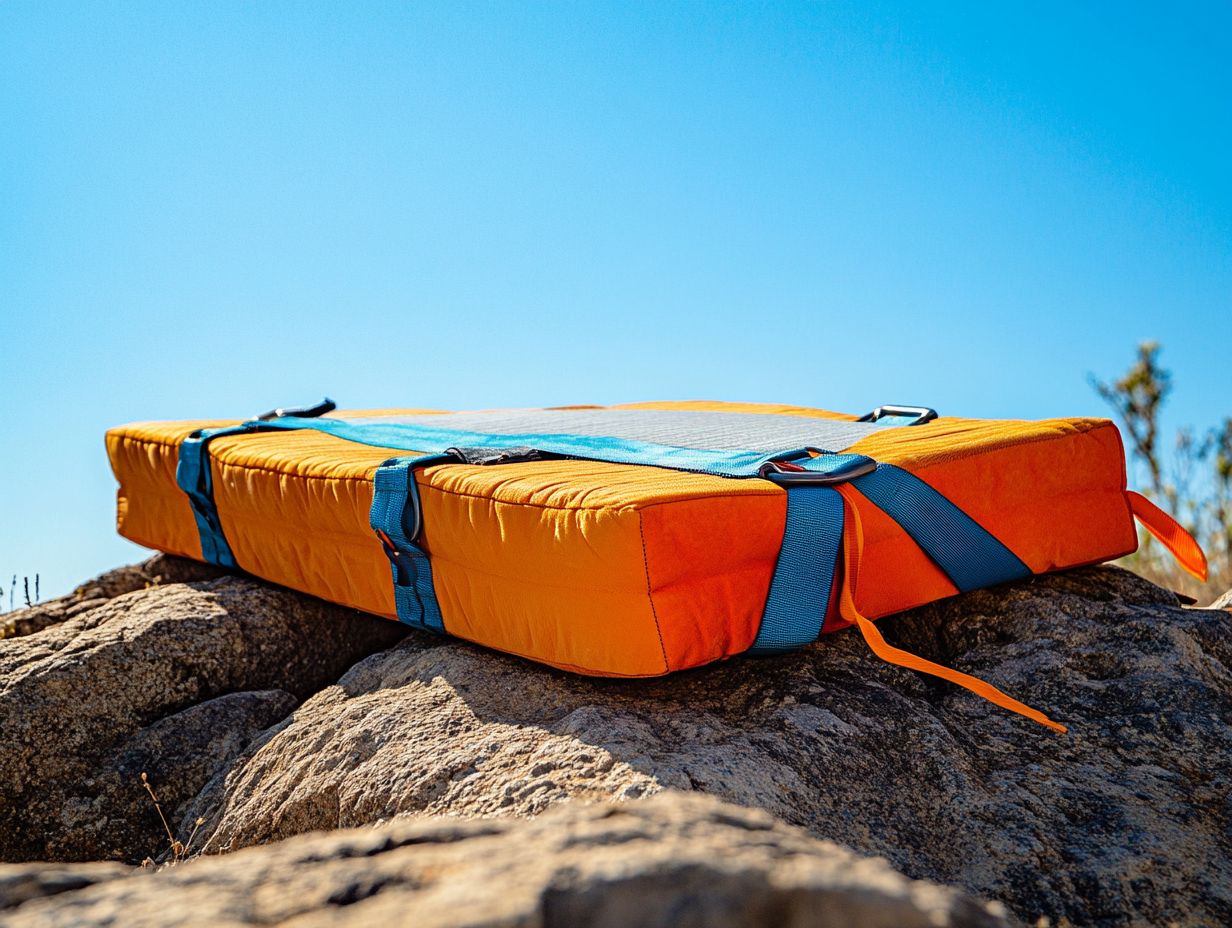
Portability and size are crucial when selecting a climbing crash pad. Evaluate the available pad sizes, from medium to large. Consider how easily you can transport and store the pad during your climbs.
Larger pads offer more surface area and better impact absorption but can feel unwieldy, often weighing 15 pounds or more. In contrast, medium-sized pads provide a good balance, offering sufficient protection without sacrificing transport convenience.
Many models feature carrying handles for enhanced portability, allowing you to easily sling the pad over your shoulder or attach it to your backpack. Folding or rolling certain pads makes storage effortless, ensuring they can be tucked away in your vehicle or small living spaces.
Comfort and Cushioning
Prioritize comfort and cushioning when choosing your climbing crash pad. These features dramatically enhance your safety and enjoyment during climbs. Effective crash pads incorporate various designs, such as hybrid hinge (a design that allows for flexibility and movement during landings) and taco designs, optimizing comfort with a strategic layering approach using foam for enhanced cushioning.
These designs elevate your overall experience and play a crucial role in your safety during sudden impacts. The layering strategy typically features high-density foam at the base for maximum shock absorption, complemented by softer top layers for added comfort. This combination minimizes the risk of injury.
The materials used in construction can also enhance durability, giving you confidence that your gear can handle repeated use. Ultimately, selecting the right crash pad means understanding these elements, as they shape your ability to focus on your technique rather than worrying about the fall itself.
Types of Climbing Crash Pads
When it comes to climbing crash pads, you’ll find a range of options on the market, mainly divided into foam pads and air pads. Each type boasts distinct safety features and material designs tailored to various climbing styles and personal preferences. Familiarizing yourself with these differences will empower you to make informed choices when selecting the perfect crash pad for your needs.
Foam Pads vs. Air Pads
Foam pads and air pads are your two primary options for impact absorption and cushioning during bouldering. Each offers unique benefits and drawbacks tailored to your specific needs. Foam pads are known for their reliable cushioning and solid impact protection, while air pads excel in portability but may not provide the most consistent cushioning.
If you’re navigating challenging terrains or planning longer hikes to your climbing spots, the lightweight nature of air pads can be a game changer. They fit easily into your backpack without adding significant weight. On the other hand, foam pads provide a stable surface, ideal for those unpredictable falls, allowing you to focus on your ascent rather than stressing about your landing.
While foam pads typically boast more durability under rough conditions, air pads require a bit more care to avoid punctures, making them less suitable for rocky environments. Assess your specific situation, weighing the need for stability against the convenience of your gear selection.
Choosing the Right Climbing Crash Pad
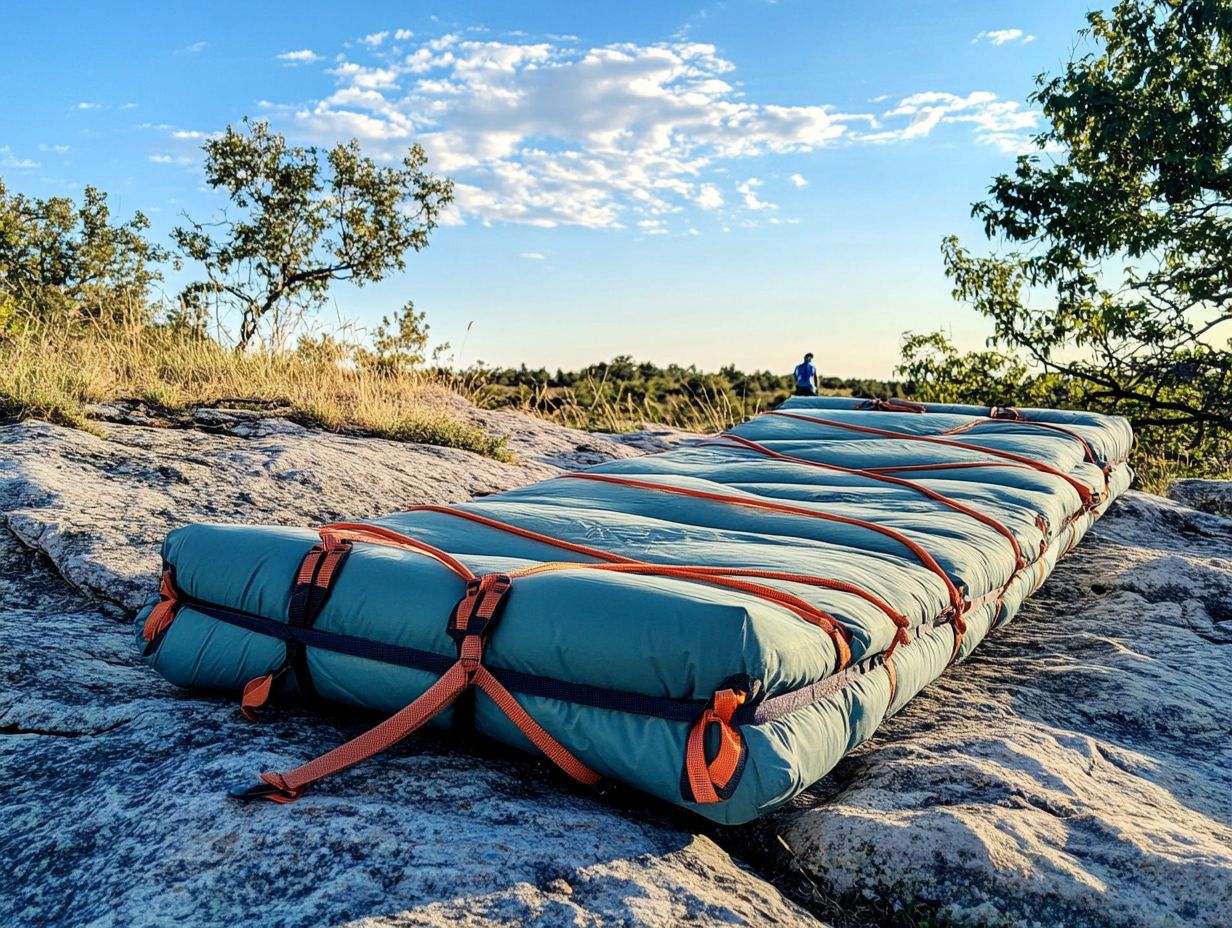
When selecting the ideal climbing crash pad, consider several key factors. Your personal climbing style, the size of the pad, and your budget will all play a vital role in ensuring you choose a pad that aligns with your needs and enhances your climbing experience.
This decision is crucial for beginners. Understanding your options will help you choose the perfect climbing crash pad. Choosing the right pad is essential for your safety. Don t compromise on your gear!
Considerations for Different Climbing Types
When selecting a crash pad, consider the specific type of climbing you pursue. Different types require varying safety features and foam densities for optimal performance. For instance, high-impact sport climbing needs a pad with superior impact absorption and sturdiness, unlike the more relaxed needs of casual bouldering.
Each climbing type presents unique risks and challenges, making your choice of crash pad crucial. An overhung boulder problem may require a thicker pad designed to minimize injury during falls, while a simple downclimb can benefit from a lighter, portable pad that’s easy to carry.
Features like sturdy buckles and reinforced corners are essential for securing the pad against shifting forces. Adequate gear storage options are also important; pads with pockets for your climbing shoes, chalk bags, and quickdraws enhance the experience, allowing you to focus on safety and performance.
This holistic approach ensures you re well-equipped for your climbing adventures, regardless of the style you choose to embrace.
Budget and Personal Preferences
Your budget and personal preferences greatly influence your decision when choosing the right climbing crash pad, as prices can vary widely based on brand, design, and features.
When exploring your options, weigh the different price points from popular brands like Black Diamond, Petzl, and Mad Rock. Each brand has its unique strengths be it top-notch cushioning, exceptional portability, or eye-catching design. Your preferences will play a crucial role here; you might prefer a lightweight model for hassle-free transport, while someone else may prioritize added thickness for maximum protection.
Evaluate features like a durable cover and the right size to narrow down your choices. This ensures you find a crash pad that fits comfortably within your budget while meeting your individual climbing needs.
Frequently Asked Questions
What Makes a Good Climbing Crash Pad?
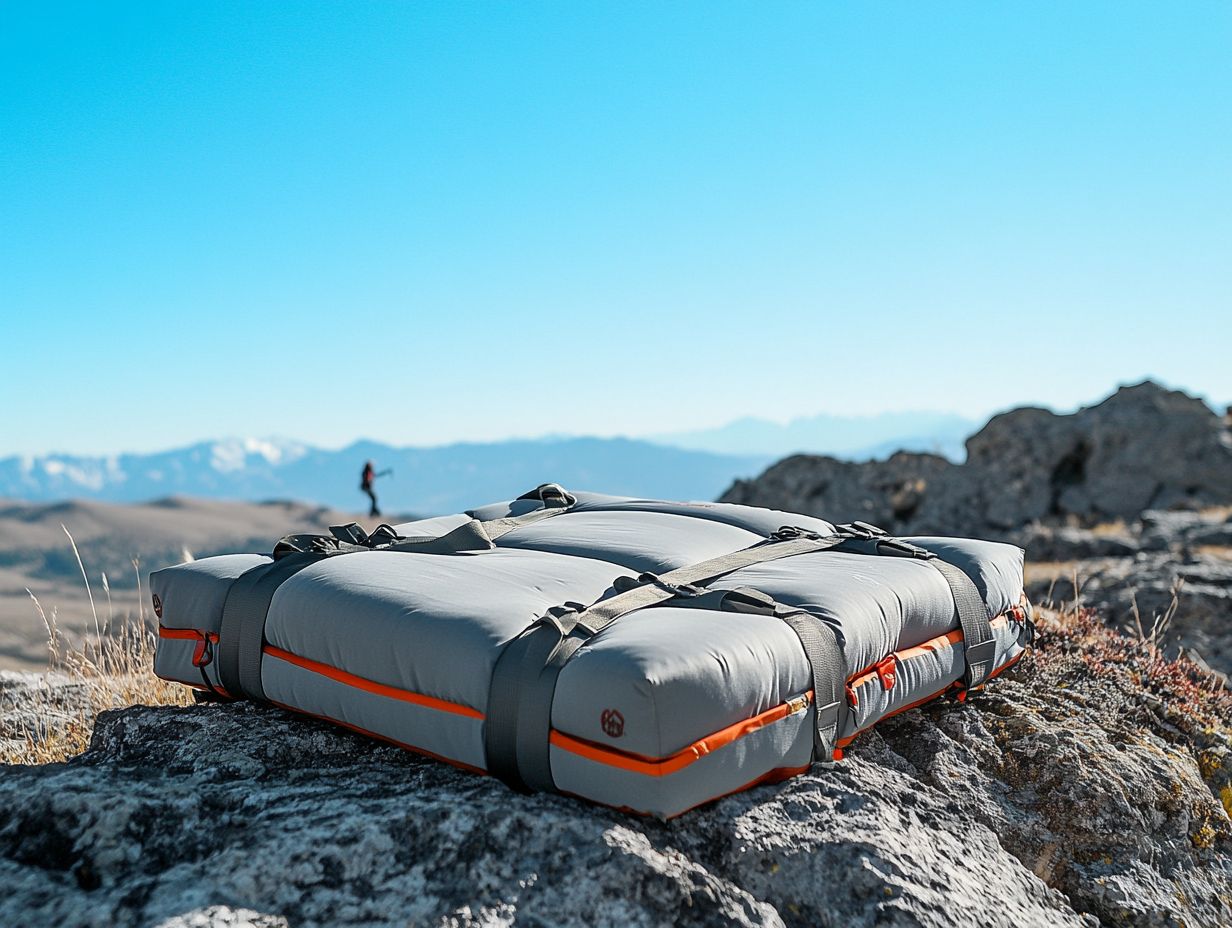
A good climbing crash pad provides necessary cushioning and support to protect you from injury while bouldering or climbing. It should also be durable, portable, and easy to use.
What Materials Are Best for a Climbing Crash Pad?
The best material for a climbing crash pad is closed-cell foam, which absorbs shock well and is lightweight and durable. A durable outer shell made of materials like nylon or Cordura is also important for withstanding outdoor wear and tear.
Are Thicker Crash Pads Always Better?
No, thicker crash pads are not always better. While they may provide more cushioning, they can also be heavier and cumbersome to carry. Finding a balance between thickness and weight is essential when choosing a crash pad.
What Features Should I Look for in a Climbing Crash Pad?
A good climbing crash pad should have a non-slip bottom to prevent sliding on uneven terrain. It should also have sturdy handles for easy carrying and multiple fold lines for convenient packing and storage. Some crash pads include extra features like gear pockets and a waterproof coating for moisture protection.
How Many Crash Pads Do I Need for Bouldering?
The number of crash pads needed for bouldering depends on the height and difficulty of the climb, as well as the landing area. Generally, it’s recommended to have at least two crash pads for adequate coverage and fall protection.
Can I Use a Climbing Crash Pad for Other Outdoor Activities?
Yes, a climbing crash pad can also serve other outdoor activities like camping or hiking. Its durable construction and cushioning make it great for sitting or sleeping on rough terrain. However, avoid using it for activities that could damage it, such as being a tent footprint or a ground cover.

